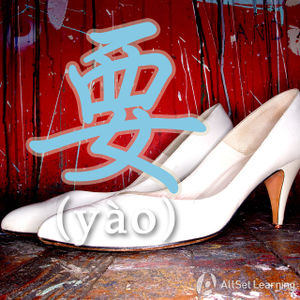Difference between revisions of "Expressing "either... or..." with "yaome""
| Line 19: | Line 19: | ||
*<em>要么</em> 你 去,<em>要么</em> 他 去 。<span class="pinyin"><em>Yàome</em> nǐ qù, <em>yàome</em> tā qù.</span><span class="trans">Either you go, or he goes.</span> | *<em>要么</em> 你 去,<em>要么</em> 他 去 。<span class="pinyin"><em>Yàome</em> nǐ qù, <em>yàome</em> tā qù.</span><span class="trans">Either you go, or he goes.</span> | ||
*<em>要么</em> 现在 就 买 ,<em>要么</em> 现在 就 走 。<span class="pinyin"><em>Yàome</em> xiànzài jiù mǎi, <em>yàome</em> xiànzài jiù zǒu.</span><span class="trans">Either buy it now, or we get out of here now.</span> | *<em>要么</em> 现在 就 买 ,<em>要么</em> 现在 就 走 。<span class="pinyin"><em>Yàome</em> xiànzài jiù mǎi, <em>yàome</em> xiànzài jiù zǒu.</span><span class="trans">Either buy it now, or we get out of here now.</span> | ||
| − | *<em>要么</em> | + | *你 <em>要么</em> 回 老家 ,<em>要么</em> 留在 上海 。<span class="pinyin">Nǐ <em>yàome</em> huí lǎojiā, <em>yàome</em>? ? Shànghǎi.</span><span class="trans">You either go back to hometown or stay in Shanghai.</span> |
| − | *<em>要么</em> | + | *<em>要么</em> 看书 ,<em>要么</em> 写 作业 ,不 可以 出去 玩 。<span class="pinyin"><em>Yàome</em> kàn shū, <em>yàome</em> xiě zuòyè, bù kěyǐ chūqù wán.</span><span class="trans">You either read or do homework. No playing outside.</span> |
*去年 夏天 ,我 每天 <em>要么</em> 去 健身,<em>要么</em> 去 图书馆,特别 无聊 。<span class="pinyin">Qùnián xiàtiān, wǒ měi tiān <em>yàome</em> qù jiànshēn, <em>yàome</em> qù túshūguǎn, tèbié wúliáo.</span><span class="trans">Last summer I either went to the gym or the library every day. It was so boring.</span> | *去年 夏天 ,我 每天 <em>要么</em> 去 健身,<em>要么</em> 去 图书馆,特别 无聊 。<span class="pinyin">Qùnián xiàtiān, wǒ měi tiān <em>yàome</em> qù jiànshēn, <em>yàome</em> qù túshūguǎn, tèbié wúliáo.</span><span class="trans">Last summer I either went to the gym or the library every day. It was so boring.</span> | ||
| − | *我 老公 周末 <em>要么</em> 睡觉 ,<em>要么</em> 打 游戏 ,从来 不 做 家务 。<span class="pinyin">Wǒ lǎogōng zhōumò <em>yàome</em> shuìjiào, <em>yàome</em> dǎ yóuxì, cónglái bù zuò jiāwù.</span><span class="trans">My husband either sleeps or plays | + | *我 老公 周末 <em>要么</em> 睡觉 ,<em>要么</em> 打 游戏 ,从来 不 做 家务 。<span class="pinyin">Wǒ lǎogōng zhōumò <em>yàome</em> shuìjiào, <em>yàome</em> dǎ yóuxì, cónglái bù zuò jiāwù.</span><span class="trans">My husband either sleeps or plays video games on weekends. He never does chores.</span> |
</div> | </div> | ||
Revision as of 02:59, 26 December 2017
-
Level
-
Similar to
-
Used for
-
Keywords
When used by itself, 要么 is a not-so-pushy suggestion. But when used for a pair of choices, it gives a much more hardline "either/or" feel: these are the two choices. Choose one. (It can also be used for more than two choices, but it's usually just two.) In this case, 要不 acts exactly like 要么.
Structure
You can give a series of alternatives by using 要么 (yàome). The structure is pretty versatile, as you can put a wide variety of things after each 要么.
It can be used both for commands and non-commands.
要么 + Option A ,要么 + Option B
Examples
- 要么 你 去,要么 他 去 。Either you go, or he goes.
- 要么 现在 就 买 ,要么 现在 就 走 。Either buy it now, or we get out of here now.
- 你 要么 回 老家 ,要么 留在 上海 。You either go back to hometown or stay in Shanghai.
- 要么 看书 ,要么 写 作业 ,不 可以 出去 玩 。You either read or do homework. No playing outside.
- 去年 夏天 ,我 每天 要么 去 健身,要么 去 图书馆,特别 无聊 。Last summer I either went to the gym or the library every day. It was so boring.
- 我 老公 周末 要么 睡觉 ,要么 打 游戏 ,从来 不 做 家务 。My husband either sleeps or plays video games on weekends. He never does chores.



